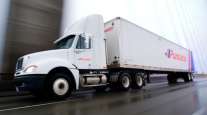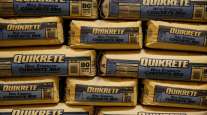CRST Acquires Specialized To Expand Menu of Services
This story appears in the Aug. 8 print edition of Transport Topics.
Truckload carrier CRST International has significantly expanded its menu of services with the acquisition of Specialized Transportation Inc., making for the second merger this year of two of the nation’s 100 largest for-hire trucking companies.
CRST, No. 26 on the Transport Topics list of the 100 largest for-hire carriers in the United States and Canada, capped a process that began last year, when it completed on July 28 the purchase of STI, No. 82 on the TT 100 list, for an undisclosed amount. CRST estimated that next year the reconfigured company will have combined annual revenue of $1.3 billion, enough for 20th place on the TT for-hire list.
“STI has an extensive network throughout the U.S. and Canada with their 45 distribution centers,” said CEO David Rusch of CRST, who added that he first approached Specialized more than a year ago.
Rusch said CRST mainly paid cash for Specialized but also took on some debt, which he thinks can be paid off by the end of this year. He said Specialized CEO Ian Nicolson will continue in that position for about two years before retiring.
Starting life in 1955 as Cedar Rapids Steel Transport, running metal from Chicago to Iowa and beef back to the Windy City, CRST has grown by adding van expedited services, dedicated contract carriage, flatbed transportation and non-asset-based logistics, with STI as its new fifth division.
STI, Fort Wayne, Ind., was founded in 1965 by North American Van Lines and spun off in 2004 by the household goods mover. It uses a network of owner-operators and agents to move high-value, specialized freight.
Rusch began his career at North American in the 1980s. During his time there, Rusch said, he met many of the people who would eventually run STI.
Both companies are privately held, with the family of founder Herald Smith owning CRST. John Smith, Herald’s son, is the carrier’s chairman.
STI was owned by a group of 29 agents, with John Sands serving as chairman. Rusch said Sands will continue to run his agency in New York.
For the 12 months ended June 30, CRST had revenue of $947.5 million. If the merged company hits the estimate of $1.3 billion, that would be growth of 37% and CRST’s largest acquisition ever, but Rusch said that is not a prelude to going public.
“The Smith family owns CRST and they want to keep it private,” Rusch said.
The other intra-TT 100 acquisition this year was TransForce Inc., then No. 14, purchasing Dynamex Inc., then No. 61, on Feb. 23 for $221.2 million.
Acquisitions are coming back to trucking after going into hibernation during the recession (see story, p. 13). In addition to the TransForce-Dynamex deal, several purchases have been announced in recent months, including two by less-than-truckload carrier Roadrunner Transportation Systems (p. 5) and one by Contrans Group (p. 8).
“There is an urge to merge out there. As carriers try to fulfill whatever strategic plans they have developed — whether diversification or specialization — they have to do something different to cope with the explosion in regulations and the aftermath of the Great Recession,” said Lana Batts, a managing partner of Transport Capital Partners.
“This was certainly not a tuck-in acquisition by CRST. It was much more than just incremental and it suggests they want to diversify,” said Batts.
Having survived the recession, many older entrepreneurs are eager to sell out now, Batts said. The problem with doing so, though, is that current company owners want to sell based on projections of future earnings, which might reasonably be healthy, but buyers want to track the recent past, when earnings were either negligible or non-existent.
“There’s a pretty wide [gap] between them, so we’re seeing negotiations that are a long, arduous process,” Batts said.
Gregory Rumble, chief operating officer of Contrans, said after his company’s acquisition that the Woodstock, Ontario, carrier is looking to buy more.
“From a corporate standpoint we’re looking for more and we have a very helpful balance sheet,” with equity exceeding liabilities. Rumble conceded that management is concerned about the course the economy might take, but that they are still evaluating acquisition opportunities.
For CRST, Specialized was an opportunity to add an entirely new line. Rusch said CRST salesmen will prospect among STI customers and vice versa.
“There is a lot of synergy to be had. For instance, STI has enormous warehousing capability, and our Expedited division customers have been asking us for that — and now we can do it.
“On the other side, they have a good base of Fortune 100 customers that we can now approach,” Rusch said.
Many STI customers are in the technology, health care, trade show and furniture industries. Rusch said their loads might be dental chairs or heart machines, and that while STI drivers get paid by the mile for driving they also earn money based on packing, set-up and delivery fees.




